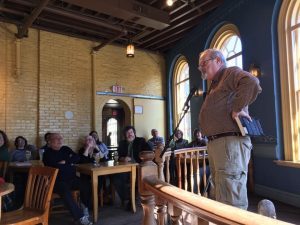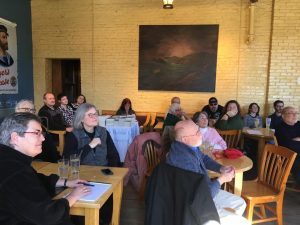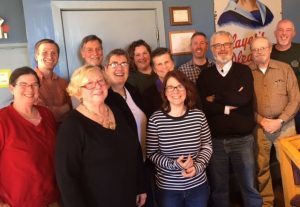Kathy Lynn Emerson's Blog, page 47
April 7, 2017
Weekend Update: April 8-9, 2017
 Next week at Maine Crime Writers, there will be posts by Kate Flora (Monday) Barb Ross (Tuesday), Brenda Buchanan (Wednesday), Maureen Milliken (Thursday), and Kathy Lynn Emerson/Kaitlyn Dunnett (Friday).
Next week at Maine Crime Writers, there will be posts by Kate Flora (Monday) Barb Ross (Tuesday), Brenda Buchanan (Wednesday), Maureen Milliken (Thursday), and Kathy Lynn Emerson/Kaitlyn Dunnett (Friday).
In the news department, here’s what’s happening with some of us who blog regularly at Maine Crime Writers:
from Kaitlyn Dunnett: I’m doing another Goodreads giveaway, this time of four copies of the audiobook version of Kilt at the Highland Games (Liss MacCrimmon #10). The audiobook was produced by Dreamscape on CD and the book is read by Tanya Eby. To enter, go to:
https://www.goodreads.com/giveaway/sh...
That doesn’t seem to be coming up as a hyperlink, so you may have to cut and paste. Or you can search for the title and scroll down to see giveaways.
An invitation to readers of this blog: Do you have news relating to Maine, Crime, or Writing? We’d love to hear from you. Just comment below to share.
And a reminder: If your library, school, or organization is looking for a speaker, we are often available to talk about the writing process, research, where we get our ideas, and other mysteries of the business. Contact Kate Flora
April 6, 2017
“What Am I Really Writing About?”
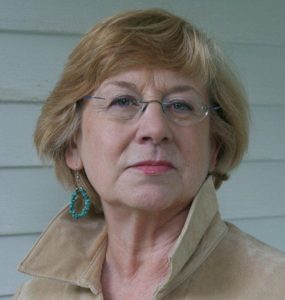 Lea Wait, here, thinking about personal passions and interests and how they can become themes, in life and in writing.
Lea Wait, here, thinking about personal passions and interests and how they can become themes, in life and in writing.
As a child I was fascinated by books (often set in the nineteenth century) about orphans who found caring homes. As an adult in my mid-twenties I volunteered with abused children in New York City. When I was thirty I adopted my first daughter.
When I was in my mid-forties, the single adoptive parent of four daughters, caring for my mother and working for a large corporation, a major publisher contacted me and asked me to write an autobiography about being single and adopting older children.
I’d been writing for adoption publications. I’d spoken at adoption conferences as an adoption advocate. I’d counseled prospective parents (both single and married) about adopting older children.
But when that publisher called, I did some hard thinking. My four daughters were teenagers then, all coping with major (different) issues. As a family we were going through difficult days. As a parent, I was struggling, too. I was clinically depressed and trying to find the strength to guide my children through their struggles while I was also challenged by a changing workplace and my mother’s illnesses.
But I believed we’d all survive. My girls would become strong and capable and productive adults, and I would go on to the next phase of my life.
Much as I was thrilled to be offered the opportunity to write a book, I didn’t want a memoir of those difficult days to be published, and perhaps to haunt the healthy futures of my daughters.
I not only turned down the publisher, I stopped writing and talking about adoption, and started writing fiction.
Fiction was different. It wasn’t my life.
I could write about anything. Anything but adoption.
I’d always loved historical fiction. I was fascinated by the past, and how ordinary people had lived then. I believed everyone had secrets, large and small, and that, more often than they knew, those secrets changed their lives.
In time, my children found their own ways, as I had hoped — had believed — they would.
I wrote mysteries for adults and historical fiction for young people.
About five years after my first book was published, a manuscript I’d been working on for more than a year was rejected, sight unseen, by my publisher. They’d decided they didn’t want a book on that topic. My editor asked me to come up with another book to meet my deadline. I was crushed by the loss of a book I’d loved, and, although I tried, couldn’t come up with another subject I wanted to write about.
Finally, after several months, I had lunch with my editor and told her how frustrated I was. None of my ideas were coming together. I was lost, and afraid. Nothing was working.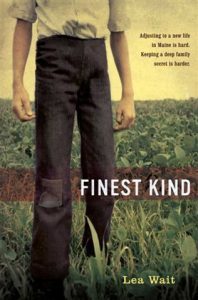
My editor was calm and understanding. “Well,” she said, “all your books are about a quest for home. Sometimes that means family, sometimes it means place, or purpose. But all of your characters are searching for a place they can be loved and accepted for themselves.”
I was stunned. I hadn’t realized that. And yet, thinking of what I’d written, my editor was right.
The book I wrote after that lunch was Finest Kind, set in 1838, about a family that has a secret that changes the way they interact with their community. My major character, thirteen-year-old Jake, also discovers that other families have secrets, too.
Since then I’ve written books for both adults and children. My nineteenth book was just published (a mystery, Tightening the Threads,) about a character whose whole life and family have been a secret, until now.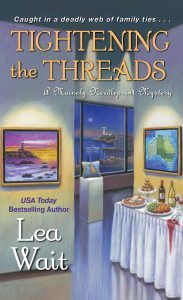
I don’t always think about quests for family and secrets when I’m starting to write a book. But my characters and plot always seem to lead me in those directions. And now I’m more conscious of that happening, and I’ve accepted that it’s all right. Searching for family and home and helping others to do the same has been a theme of my life. It’s not strange that it’s now a theme in my writing.
In my books, that search seldom involves adoption directly, although in my Shadows Antique Print series my protagonist, Maggie Summer, did adopt an older child. (In Shadows on a Morning in Maine.)
I’m writing the beginning of a new series, now. The two protagonists are sisters who have just met for the first time. They have very different background and goals. And yet, they are both my characters. They find part of themselves in each other. They become family.
I hadn’t thought of that when I imagined the series. But I’m not surprised by it.
I suspect that most authors have similar experiences, consciously or unconsciously. That the same themes run through their work. Readers, too, seek out books that reflect the themes of their aspirations, or their lives.
Is that true for you?
April 5, 2017
Dive! Dive!
From the Department of Redundant Self-Promotion Department:
Reading and talk at South Portland Library Saturday 5/13 at 2 PM
Panel with Kate Flora and Lea Wait Thursday 5/18 at Gray Public Library
Signed contracts this week for In Solo Time, the prequel to Solo Act, for publication in 2017.
Now on to our regularly schedule programming . .
I was watching that great documentary movie of hippies at sea and fly-fishing in Key West in the 60’s, Tarpon, [image error]the other night and heard my spirit bear, the great big one-eyed boy Jim Harrison, declaim the following:
“Age brings us a diminished portfolio of enthusiasms.”
The fact that he was somewhere in his twenties robs this of some of its authority but the phrase stuck in my mind nevertheless. I suspect my interpretation is not what Harrison intended in his louche and world-weary cry to the losses of age. I took what he said as a warning not that getting older narrows the set of things you care about, but the reverse, that lessening the number of things you are enthusiastic about ages you before your time. But as someone sniffing at the early edges of old age (I can but hope . .) I don’t feel a need to expand or diminish my range of enthusiasms as much as I want to deepen the ones I have.
I’ve always been catholic about the writing I’ve taken on (though I refuse to perpetrate poetry any more). But an idea will occur to me that needs an essay or I’ll get interested in something factual like a biodegradable six-pack ring developed by a Florida brewery and want to learn enough about it to write a nonfiction piece. And always, of course, the stories and novels, crime-focused and not.
and want to learn enough about it to write a nonfiction piece. And always, of course, the stories and novels, crime-focused and not.
But thinking about Harrison’s words brought me to the realization I need to widen the scope of my reading too, which is turning out to be more difficult than I thought. I have to make a conscious effort to expand my attention to places and people I don’t normally attend to. Which I suppose is the point.
I started reading very young with the adventures of Tom Swift, the Hardy Boys, then graduated to Alfred Hitchcock and Ellery Queen Magazine. For me the age of paperbacks was golden and even now, the rotund silhouette of Nero Wolfe 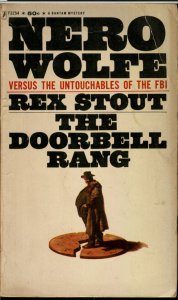 on a cover promises joy, if a completely familiar one.
on a cover promises joy, if a completely familiar one.
Except for a brief and unfortunate attempt to read (and write) like an honest-to-god English major, my choice of reading material has always been crime stories, murder mysteries, thrillers. You can imagine my joy after reading The Deep Blue Goodbye at discovering that Travis McGee had twenty other adventures and that John D. had written scores more books for me to read on streetcars, family car rides, and in summer cottages.
And when I started writing crime fiction seriously, I was mad for help, reading and rereading all my heroes for their virtual mentoring, learning everything I could without being taught directly. Lessons from Robert Parker, Elmore Leonard, John Sanford. Marcia Muller, Patricia Highsmith.
Until I realized the narrowness of my reading was squeezing my writing. I knew how to make some things happen on the page, in certain ways, in certain tones and colors. But there are things that are beyond me. Many things. One of my mentors, the great Thomas Williams Jr., told his students once of receiving a note from John D. MacDonald himself, complaining mildly about the fact that he was constrained to certain ways of writing, both by his success and by long practice.
Well, look. If you are a writer, some things are always going to be beyond you. If you don’t know that, you don’t know a thing. But it doesn’t mean you don’t want to reach for them.
And my deliberate strategy for reaching beyond where I am is to try to read things that don’t attract my shiny magpie attention: authors I don’t know, genres I don’t know, or even—gasp—books out of genre altogether (whatever genre means any more).
It piques me in some interesting ways, forces me to broaden and deepen the characters I write about, work a little harder at creating stories that are better, larger, richer than I’ve been able to do up until now. It’s an attempt to intensify one of the enthusiasms I already have (preferably without losing any of the others).
But if the portfolio must diminish over time, as my boy Jim suggests? What I want then is that each remaining enthusiasm allows me to go deeper and be as engaged as my efforts can make it. Or in the words of that other great seagoing movie, Submarine Command? Dive! Dive!
Noir at the Bar Redux
As Bruce Coffin noted yesterday, on Sunday a group of us gathered at Bull Feeney’s in Portland for Noir at the Bar, thanks to the great organization of Brenda Buchanan. Each of us read a small passage from one of our works.
I had invited some friends and one couple showed up with their daughter who wants to be a writer. Talking with her before Noir started reminded me what a benefit events like that are, and also what a benefit groups like Maine Crime Writers are. As we all know, writing is a very solitary endeavor. Certainly, there are parts that are not solitary. There are many opportunities for collaboration and critique groups and the like, but writing is primarily a digging deep into ourselves and our imaginations. Sometimes, after a lot of digging, we find water (or oil, depending on what we’re looking for), but sometimes that hole can get a little deep and dry.
Events like Noir remind me what a wonderful, supportive community we all write in. It is a joy to hear smart people put pieces of their imagination on display.
It inspired me. And I hope it inspired my friends’ daughter.
To check out books by Brendan as well as by his father and son, visit their website.
April 4, 2017
Noir at the Bar
Bruce Robert Coffin here, manning the helm of the Maine Crime Writers’ Blog and trying to navigate a course to spring. In the past four days we’ve had two major snow storms and two days of fifty degree temperatures. Perhaps Samuel Langhorne Clemens was right.
This past Sunday I took part in a group reading known as Noir at the Bar. It was the second such reading conducted by a dozen Maine mystery authors at Bull Feeney’s in Portland’s Old Port. Always a lively crowd and the stories flow as freely as the libations. Each author is given an opportunity to set up the scene followed by three minutes of actual reading. The event is a lot of fun, for both the readers and the listeners. Passages are read from our latest books, those on the horizon, and occasionally from some of our older well-loved works.
Various photographs were posted on social media following the event. The pictures that most often draw my attention are those of the listeners. Enthralled by whichever yarn was being spun at the time, their faces are not unlike those of the children in a classroom during afternoon story hour. Eyes wide and mouths agape as adjective laden prose whisks them through the secret worlds of each reader. The visions of the tales spun are limited only by the imagination of the listener. As I look at the photos I can’t help but be transported back in time to third grade when Mrs. Dunham would captivate us with tales of Charlie Bucket and his grand prize tour of Wonka’s secret factory. The vivid descriptions of Dahl’s confectionery creations delighted each of our ravenous young imaginations.
The well-crafted written word is bested only when delivered vocally by the writer with the precision and passion of an orchestra conductor. Storytelling that engrosses the open mind, freeing it to travel in whichever direction the author may lead us. Have you attended an author reading? Join us, won’t you?
April 2, 2017
The Spy in the WiFi
About a year ago, I began to suspect that I might have sleep apnea, a condition where a person stops breathing while sleeping. When they start breathing again, it usually wakes them up, which does not make for a restful night. After two sleep studies, one at the hospital (see http://mainecrimewriters.com/kaitlyns-posts/sleep-glorious-sleep) and one at home, the verdict was that I stop breathing for more than ten seconds an average of twenty-five times a night. Yup, that’s sleep apnea alright. And it could explain why I was taking a lot of naps during the day.
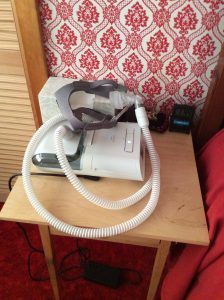 The recommended treatment for sleep apnea is something called a CPAP machine. Until about a month and a half ago, I was still “waiting for paperwork” to come through. Then I went in to a local medical supply outlet to collect my CPAP, try on various types of mask to find the most comfortable one, and receive a short tutorial. That’s when I found out there are strings attached.
The recommended treatment for sleep apnea is something called a CPAP machine. Until about a month and a half ago, I was still “waiting for paperwork” to come through. Then I went in to a local medical supply outlet to collect my CPAP, try on various types of mask to find the most comfortable one, and receive a short tutorial. That’s when I found out there are strings attached.
Insurance paid to buy various attachments, including the mask, a six foot air hose (heated, yet), and, of all things, a humidifier. I now own these. But the CPAP itself is only rented. Insurance will pay the rent for the first year. Only if I’m still using it at the end of that period they will buy the thing and give it to me for my very own.
Now, I do understand that some people just can’t adjust to wearing a mask overnight, especially the full-face kind. In my case, though, I only need a nose piece and the straps to hold it in place. It reminds me a lot of the “nightcap” I wore for a couple of years back when I had braces as a teenager . . . only much more comfortable. But here’s the kicker: I am not to be trusted to use the CPAP without supervision.
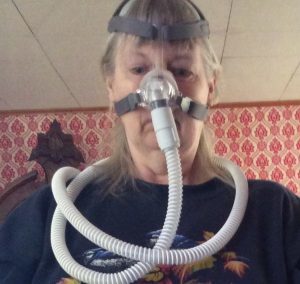 You’d think that a sixty-nine-year-old woman who has never missed a deadline or a doctor’s appointment, takes all her medications on schedule, and shows no signs of memory loss could be trusted to actually use the device she’d asked for, wouldn’t you? But no. I am being monitored for the first three months—spied on every night by way of a WiFi connection. Sheesh!
You’d think that a sixty-nine-year-old woman who has never missed a deadline or a doctor’s appointment, takes all her medications on schedule, and shows no signs of memory loss could be trusted to actually use the device she’d asked for, wouldn’t you? But no. I am being monitored for the first three months—spied on every night by way of a WiFi connection. Sheesh!
Do I have to comply? Yes, because they want proof that I have used the CPAP at least four hours a night for thirty consecutive days at some point during those first three months. If I don’t, they will take it away from me. Until the end of the three months, whether I’ve already met this requirement or not, they (and Santa Claus) will continue to “know when I am sleeping.” It isn’t just that they know when the machine is operational. They know whether or not I have the mask on because they can tell whether or not I am breathing. In theory this is good. They are checking whether or not the treatment is working. On the other hand, there’s something big-brotherish about it that really creeps me out.
Since this is insurance company policy (I typed “company police” first—Freudian slip?) the requirements don’t end there. I am also required to meet with my primary physician at some point between the end of the first month and the end of the third to discuss . . . well, that’s the question. There isn’t all that much to discuss. Either I’m going to use the CPAP regularly or I’m not. And my doctor tells me that, on her part, this appointment is a huge waste of time. It can’t be used to talk about anything else, so if I happen to have another health issue at the same time, I’ll have to make a separate appointment for that. Now how does that make sense? In that case, it would cost the insurance company more money, the very thing they seem to be trying to avoid.
On the bright side, I am sleeping better. I don’t expect to have any difficulty qualifying to keep my CPAP. My only complaints are minor. That six foot hose is so long that it keeps getting caught on things and there isn’t a shorter version. And as far as I’m concerned, the humidifier attachment is a total waste. The only time I end up taking off the mask in the middle of the night is when the humidity in the part that covers my nose gets so high that it makes my whole face sweat. I am probably going to disconnect that attachment, even if it does mean waking up with a dry throat.
 Since Big Brother will still be watching at the end of this month, it will be interesting to see what reaction I get when WiFi suddenly shows that I haven’t used the CPAP for four consecutive nights. You see, although the device came with a carrying case, it’s so big that if I were to take it with me to Malice Domestic I’d have to do without my usual carryon, the one that holds my meds, a change of clothing, and my iPad. On the flight to Malice, that would mean putting all my clothes in my checked bag and taking the risk that it might get lost in transit. Coming home, I’d be even less inclined to trust checked luggage. After all, on return trips from conferences my carry on bag traditionally contains all the lovely new novels I bought in the book room.
Since Big Brother will still be watching at the end of this month, it will be interesting to see what reaction I get when WiFi suddenly shows that I haven’t used the CPAP for four consecutive nights. You see, although the device came with a carrying case, it’s so big that if I were to take it with me to Malice Domestic I’d have to do without my usual carryon, the one that holds my meds, a change of clothing, and my iPad. On the flight to Malice, that would mean putting all my clothes in my checked bag and taking the risk that it might get lost in transit. Coming home, I’d be even less inclined to trust checked luggage. After all, on return trips from conferences my carry on bag traditionally contains all the lovely new novels I bought in the book room.
 Kathy Lynn Emerson/Kaitlyn Dunnett is the author of over fifty books written under several names. She won the Agatha Award for best mystery nonfiction of 2008 for How to Write Killer Historical Mysteries and was an Agatha Award finalist in 2015 in the best mystery short story category for “The Blessing Witch.” Currently she writes the contemporary Liss MacCrimmon Mysteries (Kilt at the Highland Games) as Kaitlyn and the historical Mistress Jaffrey Mysteries (Murder in a Cornish Alehouse) as Kathy. The latter series is a spin-off from her earlier “Face Down” series and is set in Elizabethan England. New in May 2017 is a collection of Kathy’s short stories, Different Times, Different Crimes. Her websites are www.KaitlynDunnett.com and www.KathyLynnEmerson.com
Kathy Lynn Emerson/Kaitlyn Dunnett is the author of over fifty books written under several names. She won the Agatha Award for best mystery nonfiction of 2008 for How to Write Killer Historical Mysteries and was an Agatha Award finalist in 2015 in the best mystery short story category for “The Blessing Witch.” Currently she writes the contemporary Liss MacCrimmon Mysteries (Kilt at the Highland Games) as Kaitlyn and the historical Mistress Jaffrey Mysteries (Murder in a Cornish Alehouse) as Kathy. The latter series is a spin-off from her earlier “Face Down” series and is set in Elizabethan England. New in May 2017 is a collection of Kathy’s short stories, Different Times, Different Crimes. Her websites are www.KaitlynDunnett.com and www.KathyLynnEmerson.com
March 31, 2017
Weekend Update: April 1-2, 2017
 Next week at Maine Crime Writers, there will be posts by Kaitlyn Dunnett/Kathy Lynn Emerson (Monday) Bruce Coffin (Tuesday), Brendan Rielly (Wednesday), Dick Cass (Thursday), and Lea Wait (Friday).
Next week at Maine Crime Writers, there will be posts by Kaitlyn Dunnett/Kathy Lynn Emerson (Monday) Bruce Coffin (Tuesday), Brendan Rielly (Wednesday), Dick Cass (Thursday), and Lea Wait (Friday).
In the news department, here’s what’s happening with some of us who blog regularly at Maine Crime Writers:
Noir At The Bar.Sunday, April 2nd.3-5 p.m. at Bull Feeney’s, 375 Fore Street, Portland, Maine. Come see an impressive cast of writer’s reading and answering questions about their writing. Books will be available for purchase and authors available to scribble (ooops) make that sign them.
2017 CrimeMaster Award: Tess Gerritsen
Friday, April 21, 2017: 5:30 p.m. 
USM’s Glickman Library, Portland
Free and open to the public
2017 Maine Crime Wave. Saturday, April 22 | 8:00 a.m. – 5:00 p.m. Glickman Library, USM, Portland. Register now! It’s filling up fast for details and schedule of events visit the MW&PA webpage http://mainewriters.org/maine-crime-wave/
An invitation to readers of this blog: Do you have news relating to Maine, Crime, or Writing? We’d love to hear from you. Just comment below to share.
And a reminder: If your library, school, or organization is looking for a speaker, we are often available to talk about the writing process, research, where we get our ideas, and other mysteries of the business. Contact Kate Flora
March 30, 2017
Sneak Peek at Works in Progress
 Now and then, we check in with our writers to see what they’re working on. Here’s the latest from our amazingly productive group.
Now and then, we check in with our writers to see what they’re working on. Here’s the latest from our amazingly productive group.
Jen Blood: In what I can only describe as a monumental loss of my senses, I’m working on three projects at the moment: Maya Picks a Puppy, a rescue-friendly children’s picture book TBR May 2, about a little girl choosing her first dog from a local animal shelter. White Out, the second novel in my Flint K-9 Search and Rescue mysteries, due out in July, and The Transport, the first novel in my new YA Flint K-9 Animal Rescue series. Tentative release for that one is fall, 2017.
Lea Wait is announcing that, yes, she has another persona. Or – at least she’ll be writing under two names. “Cornelia Kidd” has just signed a contract with Crooked Lane Books for the “Maine Café” mystery series, centered around two sisters who grew up in different worlds and have different goals, but who’ve have decided to open a restaurant together on Quarry Island, Maine. Lea’s finishing up a draft of the first book in that series, to be released in June of 2018.
Lea Wait, on the other hand, has just started work on a novella based in Haven Harbor, Maine, with the Mainely Needlepoint cast, to be anthologized in early fall of this year, and is outlining the seventh in the Mainely Needlepoint series, in which a old Maine embroidery hides family secrets … and leads to a murder today . . . to be published a year from now. (And, yes – she occasionally sleeps.)
Kaitlyn Dunnett/Kathy Lynn Emerson: Although it won’t be in stores until December, I have the cover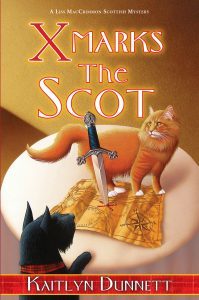 for the next Kaitlyn Dunnett, X Marks the Scot. It has to do with a treasure map found in something Liss MacCrimmon buys at an auction. Meanwhile, I’m working Crime and Punctuation, the first entry in my Deadly Edits series featuring a retired teacher turned book doctor. It will debut next June. I’m also working (as Kathy) on the fourth book in my historical Mistress Jaffrey mysteries, Murder in Colchester Gaol, which I’m writing without benefit of contract. What can I say? Sometimes just writing the whole book first works better for me than trying to sell a book with a synopsis. It’s set in England in 1585.
for the next Kaitlyn Dunnett, X Marks the Scot. It has to do with a treasure map found in something Liss MacCrimmon buys at an auction. Meanwhile, I’m working Crime and Punctuation, the first entry in my Deadly Edits series featuring a retired teacher turned book doctor. It will debut next June. I’m also working (as Kathy) on the fourth book in my historical Mistress Jaffrey mysteries, Murder in Colchester Gaol, which I’m writing without benefit of contract. What can I say? Sometimes just writing the whole book first works better for me than trying to sell a book with a synopsis. It’s set in England in 1585.
Jessie Crockett: I’ve just finished up copyedits on my second Change of Fortune Mystery, Whispers of Warning which will release in September. I’m also working on my second novel in my new Beryl and Edwina series. The first book, Murder in an English Village, will release on Halloween. These books are set in England in 1920 and feature two old finishing school friends as a pair of sleuths.
Susan Vaughan: Update on the current project. I’m writing a novella to complete The DARK Files series. Dark Vision will be the prequel, introducing a few of the agents in DARK. The protagonist, Matt Leoni, reappears as a secondary character in Dark Vengeance. I’d rather say no more until the story is finished.
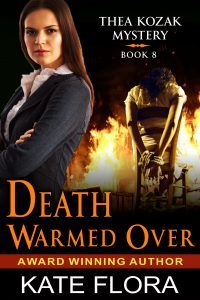 Kate Flora: In the realm of something completely different, I’ve been working on a story for a collection described as: CRIME + POLITICS: THE OBAMA INHERITANCE is a proposed anthology wherein contributors would riff on any one of dozens of teabagger-alt right conspiracy theories about Obama’s years in office and turn them on its head. So much fun to play with this. Of course, the story may yet be rejected. The 8th Thea Kozak mystery is still somewhere in limbo, but here’s the cover. Now I am back working on the 9th Thea Kozak mystery and doing edits for Shots Fired: The Misconceptions, Misunderstandings, and Myths about Police Shootings. My crime story, Ida Mae Buys an Crown Vic, will appear in the anthology, Busted, in April.
Kate Flora: In the realm of something completely different, I’ve been working on a story for a collection described as: CRIME + POLITICS: THE OBAMA INHERITANCE is a proposed anthology wherein contributors would riff on any one of dozens of teabagger-alt right conspiracy theories about Obama’s years in office and turn them on its head. So much fun to play with this. Of course, the story may yet be rejected. The 8th Thea Kozak mystery is still somewhere in limbo, but here’s the cover. Now I am back working on the 9th Thea Kozak mystery and doing edits for Shots Fired: The Misconceptions, Misunderstandings, and Myths about Police Shootings. My crime story, Ida Mae Buys an Crown Vic, will appear in the anthology, Busted, in April.
Dick Cass: Happy to report that I’m working on a contract to publish the prequel to Solo Act, In Solo Time, sometime in 2017. In Solo Time is the Elder Darrow origi n story and I hope people who enjoyed Solo Act will be compelled to find out where he came from and how the Esposito came to be.
n story and I hope people who enjoyed Solo Act will be compelled to find out where he came from and how the Esposito came to be.
Same characters, maybe a little less evolved, solving the murder of an obnoxious jazz guitarist on the stage of the Esposito.
Details as they come.
A thriller that I’m shopping, The Go-Between, won a finalist’s award at the Florida MWA conference in February. Denton Robinson, the protagonist, solves peoples’ problems for a living, staying close to the legal side though sometimes straying. In The Go-Between, a left-leaning dirty tricks organization mistakenly identifies Robinson as a hit man and tries to hire him to kill an embezzler, whose ill-gotten gains are earmarked to fund the governor’s run for U. S. Senate. My current work-in-progress is a follow-up to The Go-Between, tentatively titled The Gone.
Bruce Robert Coffin: I’m busy writing the third novel in the Detective Byron Mystery Series while awaiting copyedits on the second. Book two in the series finds Byron and his team investigating the suspicious death of a prominent Portland attorney following the loss of a multimillion dollar civil trial. Beneath the Surface, will be released on August 8th.
On the short fiction front, I’m happy to announce that my story Bygones will appear next month in the Level Best Anthology Busted: Tales from the Beat.
Vaughn C. Hardacker. I’ve just finished reviewing the ARCs of Wendigo, scheduled for release in July. Here’s a couple of blurbs based on reviews of the ARC:
In Wendigo, Hardacker gets it all right- the bone-chilling cold of the north woods, the isolation and loneliness, the quirky characters, the constant peril- and tops it off with a tense hunt for a killing legend.
—Dale T. Phillips, author of Shadow of the Wendigo
“The horror residing on the pages of Hardacker’s latest thriller is more terrifying than an old Algonquin legend. Wendigo will have you looking over your shoulder and locking your doors.”
—Bruce Robert Coffin, author of the Detective Byron Mystery Series
I have started a new series with a novel entitled The Dying of The Light, a thriller.
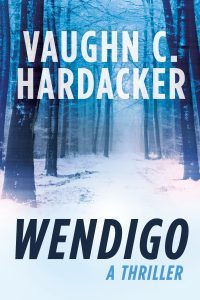
Wendigo: Coming July 2017
Dylan Thomas is a strange mix. He’s a former state police officer who paid his way through law school while working as a private investigator, now he’s possibly the only lawyer/investigator in Maine, if not New England. When his sister, Caitlin, calls him and says that her four year-old daughter is missing, Dylan becomes full-time investigator. His investigation will lead him from Maine’s northern-most county to the darker neighborhoods and streets of Boston. He tears the lid off an adoption for a fee operation that abducts and sells young white children to wealthy clients who do not want to wait on a bureaucratic system, that has a shortage of young white children, to find them a suitable child to adopt. I’m moving along, currently at the 63,ooo word mark.
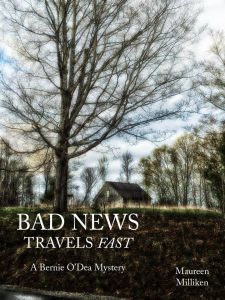
This is NOT the official cover for Bad News Travels Fast. But isn’t it cool?
Maureen Milliken: I’m working on the third book in the Bernie O’Dea mystery series. I hate to say too much about it while I’m writing — maybe it’s a little bit superstition and a lot of not wanting to let the cat too much out of the bag before the bag has been fully… oh geez, that metaphor just fizzled into nothing.
Anyway, I’ll say this: Why would someone murder someone who was lost in the woods and so far gone that she’d die anyway? Well, the new book, working title BAD NEWS TRAVELS FAST, will answer that question. The book takes place the summer after NO NEWS IS BAD NEWS, with still a lot of fallout from that deadly November in the town of Redimere, Maine, and their effect on protagonist Bernadette “Bernie” O’Dea and co-protagonist Police Chief Pete Novotny. It’s due out sometime toward the end of summer or the fall.
I’m also excited to be one of the presenters in the Short & Helpful Online Writers Workshops. My workshop, on Flashback & Backstory (and if you’ve read NO NEWS IS BAD NEWS, you’ll get why I was asked to do that one), will be available in May.
Easing Out of March While Playing God’s Pinball Machine

Put a little ZIP in your day
John Clark emptying out the post-winter drippings in the brain pan, something I encourage others to consider. After a winter spent primarily reading (and reviewing) voraciously, I’ve started writing what may be a novella, or might stretch into another book. It’s called Thor’s Wingman and I’ll share more down the road. It’s a young adult urban fantasy which is what I seem to favor these days. For those unfamiliar with the genre, it’s fiction grounded in the contemporary world with supernatural elements blended in. Charles De Lint is often acknowledged as the godfather of the genre and has written some dandies.
Anyhow, in the course of ramping up to starting, I wrote a few short stories and spent time in my head, looking at the think factory to see what was kicking about up there. I’ve always been fascinated with lightning, particularly the chain or cloud-to-cloud kind. It started when I was a kid and storms would slide over Appleton Ridge and follow the Georges River to the ocean. Heat lightning was particularly fascinating because it stayed high, had little thunder and bounced about, sometimes for several minutes at a time.
I started calling this God’s Pinball Machine sometime during high school. Later on, I realized that the name could apply equally to another of my fascinations-thinking. I just finished reading a fascinating article in the latest issue of Rolling Stone about the legal and underground research and use of psychedelics to treat mental illness, particularly PTSD. (http://www.rollingstone.com/culture/features/how-doctors-treat-mental-illness-with-psychedelic-drugs-w470673) (One drug, ibogaine, shows promise as an effective treatment for opioid addiction.) The article reminded me of what intrigued me most about the thought process (and is often mimicked in casual conversation), how we get from thought A to thought X and what ideas/images/thoughts were in between. It’s not always easy to backtrack, but I’ve found that doing so often amazes me. Stuff that at first seems totally unconnected, starts to make sense as I backtrack.
What does this have to do with writing? For me a lot, it seems. Several of my recent short stories started as a fragment as I was falling asleep, but as the process continued, I neither fell asleep not forgot the idea trail. Backing that train up helped solidify the ideas. The process of backtracking can sometimes be as intriguing as the writing process. Here’s something to try if you like. Think of someone you knew in high school or college and let your mind wander. Give yourself five minutes. I find washing dishes or weeding are really good activities for something like this. Jot down where you stopped-who/what/where, etc. See if you can follow the trail back to the original thought and see just how far from point A you went in the process. It might bore the heck out of you, but I’m really fascinated and I use some of the process to expand my plots as well as let my characters grow.
Take Jared Hills, the main character in Thor’s Wingman. He started out as a bored teen who spent his summer in a boat, fishing on the big lake not far from where he lived. I let him start thinking and when he got back to me, the amount he’d expanded as a person and what happened as he was growing up, was scary.
Here’s one more thing I’m draining from the brain pan-cast off characters. We’ve all read series with characters we related to. At some point the series ends, but what happens to characters after their creator has abandoned them? I sometimes imagine a world peopled with them. How do they feel, how do they pass the time, who connects with whom, what kind of world do they inhabit now that they’re no longer necessary?
Who would you want to hang with if you could enter such a world? What would it look like and how might you interact with them. I think it would be a total hoot to spend a weekend with Travis McGee, Katniss Everdeen and Druss The Legend. Imagine climbing into Travis’ beloved Miss Agnes and going clubbing together. That would be quite the experience.
Well good readers, who would you choose to hang with if you had a similar world peopled with lost characters? Let me know
March 28, 2017
Sick of winter and like mysteries? It’s time to catch the Maine wave
We’ve said it over and over again. In fact, it’s the whole point of this blog — Maine and it’s rich load of mystery writers are a great mix.
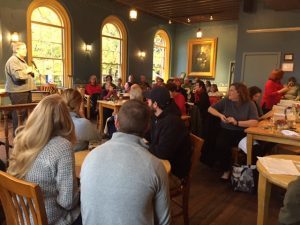
Brenda Buchanan warms up the crowd at last November’s Noir at the Bar. The spring edition is Sunday.
And April is the coolest month for fans of mysteries, writing, Maine and all that other stuff. Two really neat events are coming up in the next few weeks, and it’s a great chance to meet some writers, hear writers read from their works and talk about writing, and soak up all that’s great about Maine crime writing.
The first event is Noir at the Bar, this coming Sunday.
The twice-a-year event features writers, most of whom post on this blog, reading two-minute passages from their works. The writers run the gamut from hard-boiled and police procedural to traditional mystery to cozy and everything in between. And since it’s at a bar — Bull Feeney’s on Fore Street in Portland — what’s not to like?
The event is free and open to the public, and is 3 to 5 p.m., Sunday, April 2.
If that’s not enough, the headline event of the month — the season opener of Maine writing, in fact — is the Maine Crime Wave on April 22. The day-long conference features workshops, panels, lunch, schmoozing, books for sale and a lunch address by Maine Attorney General Janet Mills.
The event is at the University of Southern Maine’s Glickman Library in Portland, right off

Tess Gerritsen will be awarded the first Maine Crime Master award to kick of Maine Crime Wave.
Interstate 295. There’s plenty of free parking, and lots of bathrooms.
Writers and aspiring writers can take advantage of manuscript critiques and craft-specific workshops. And you don’t have to be a mystery writer to get something out of those sessions. There is plenty for non-writers, too, included Tess Gerritsen and agent Meg Ruley, talking about “The Life of a Book,” authors who were recently published — me included! — talking about how they got there, a panel by some of the former law enforcers who now are part of Maine’s great writing community, and a lot more.
One of the things I’ve always enjoyed about Crime Wave is the chance to schmooze with the writers and participants. The writers are right there with you, drinking coffee, listening to panels, lurking by the coat rack — it’s a great chance to get to know your favorite writer better and to meet new ones.
As part of the event, the night before, on Friday, April 21, Gerritsen — who’s the internationally best-selling writer of the series that sparked the “Rizzoli and Isles” TV show, if you weren’t aware — will be honored with the first annual Maine Crime Master award, also at USM.
Barbara Kelly, of Kelly’s Books to Go will be selling books by all the authors at both Noir at the Bar and Crime Wave. To find out more about Crime Wave and to register, go to the Maine Writers and Publisher’s Alliance website, mainewriters.com. Find Noir at the Bar on Facebook, or just show up. We won’t turn you away!
Spring is a great time in Maine, and these events are a great way to get out of the house and take advantage of some of the best our state has to offer, make new friends, talk about and hear about writing and writers and … did I mention get out of the house?
The first person who approaches me at Crime Wave and tells me they decided to come after reading this blog post, will get a signed copy of my first book, Cold Hard News. I’ll give it you right there. So how can you turn down an offer like that?
Maureen Milliken is the author of the Bernie O’Dea mystery series. Follow her on Twitter at@mmilliken47 and like her Facebook page at Maureen Milliken mysteries. Sign up for email updates at maureenmilliken.com. She hosts the podcast Crime&Stuff with her sister Rebecca Milliken.

